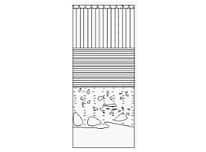The concept of soil profile refers to the vertical cuts that can be made to describe it.
It is interesting to know that this term is made up of two words fundamentally of disparate etymological origin. Thus, profile, first of all, derives from the Provençal “profile”, which was used to define the hem that certain garments had. Soil, secondly, comes from the Latin “solum”, which can be translated as “soil”.
From the surface to the bedrock , it is possible to recognize different horizons ( layers ).
 These levels, which develop inside the soil , have different characteristics. For the soil profile to be precise, with well-defined horizons, it is necessary that the soil be mature since, if it is very young, the various structures are not yet clearly differentiated.
These levels, which develop inside the soil , have different characteristics. For the soil profile to be precise, with well-defined horizons, it is necessary that the soil be mature since, if it is very young, the various structures are not yet clearly differentiated.
There are several classifications in the study of the soil profile. One of the most common includes among the most important layers Horizon A (dark in color, with little presence of mineral salts and rich in organic matter and presence of life), Horizon B (red or brown, with salts of iron, aluminum or calcium and little biological activity) and Horizon C (with fragments that derive from the weathering of the parent rock and almost without roots ).
Not to mention that there is also the bedrock already mentioned at the beginning, which is the original material on which the soil in question was developed. This can be of several types: white, impermeable, hard, made of loose materials, compact... This is also called the R horizon or even the D horizon.
However, other studies add other significant horizons to these horizons, such as the following:
-Horizon 0, also known as the H horizon. It is considered to be anything that does not have mineral material and is of an organic type.
-E horizon, also called washing horizon. It is identified by the fact that it releases mineral particles that decompose easily and, specifically, releases them towards the next horizon.
It is important to mention that the scientific discipline dedicated to the analysis of the nature and qualities of the soil is called pedology . This specialization is responsible for studying the soil profile .
It can be said, in short, that the soil profile is formed with the succession of horizons that can be seen if a cross section is made. Horizons are distinguished from each other by the size of the mineral particles they contain, the presence or absence of organic matter, color and other qualities.
The differentiation of horizons increases with the intensification of the soil formation process. There are soils where the horizons are combined, while the surface horizons are also susceptible to erosion . Drawing a soil profile is very important to know how to protect the land and promote agriculture.
Although we have already explained the main and usual characteristics that the soil profile usually indicates, we cannot forget that there are soils that differ from them. This would be the case, for example, of the so-called podsols, which exist in areas with very humid and cold climates and are characterized because in them the aforementioned A horizon is highly developed.
